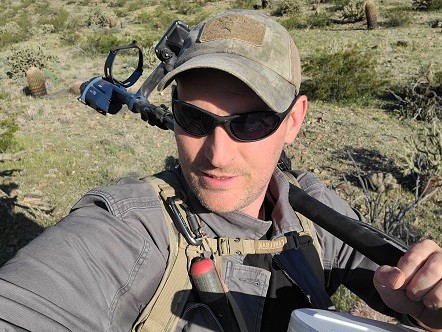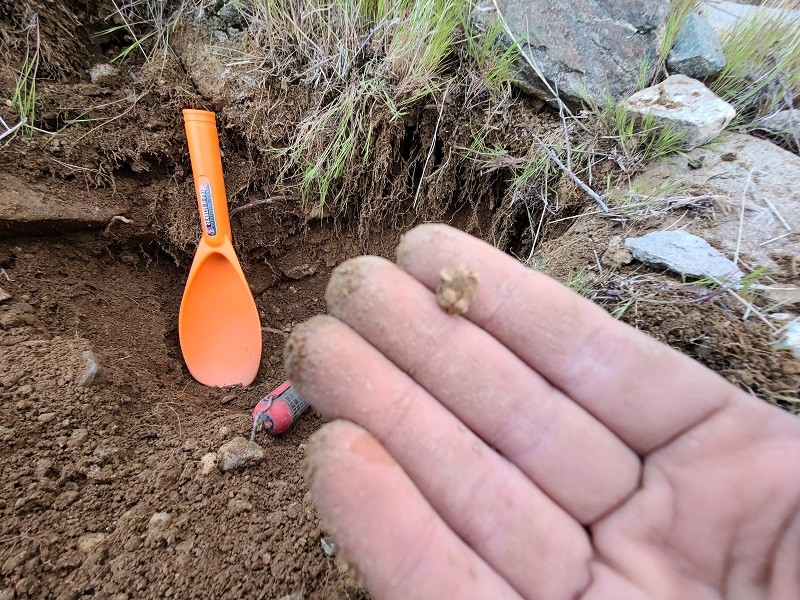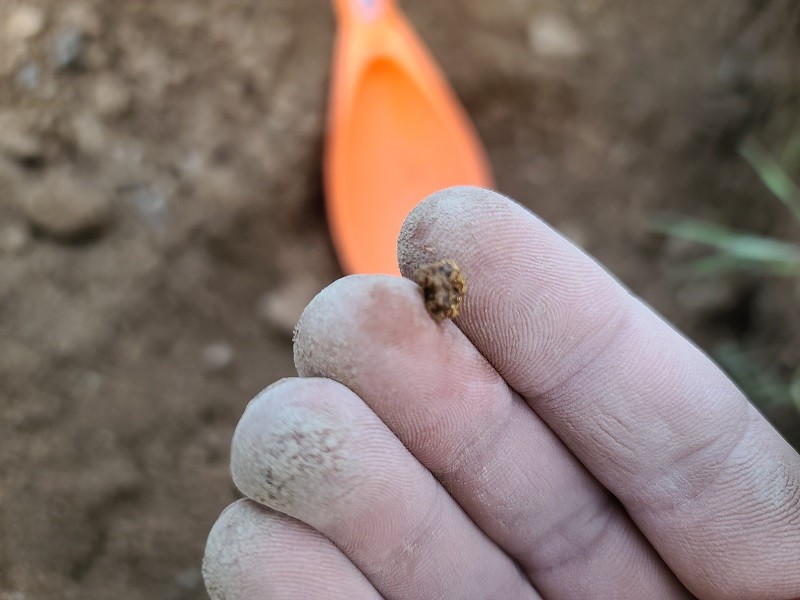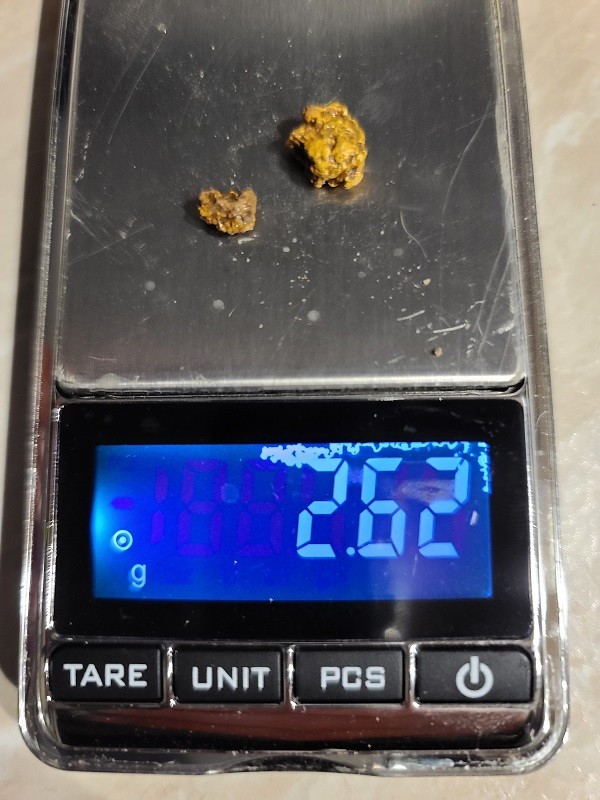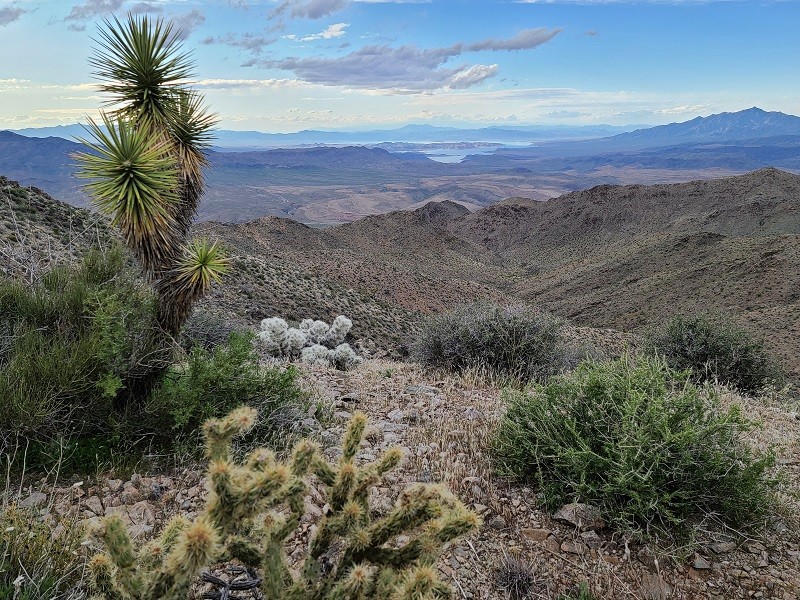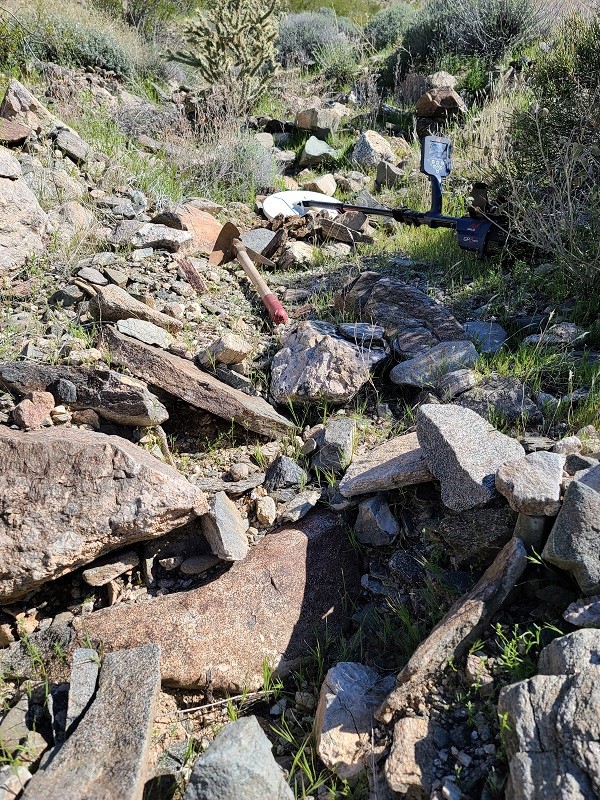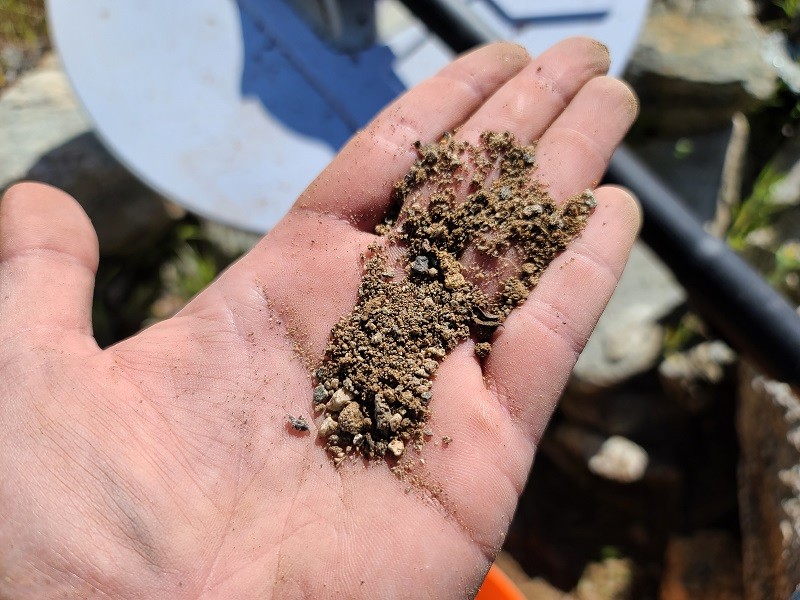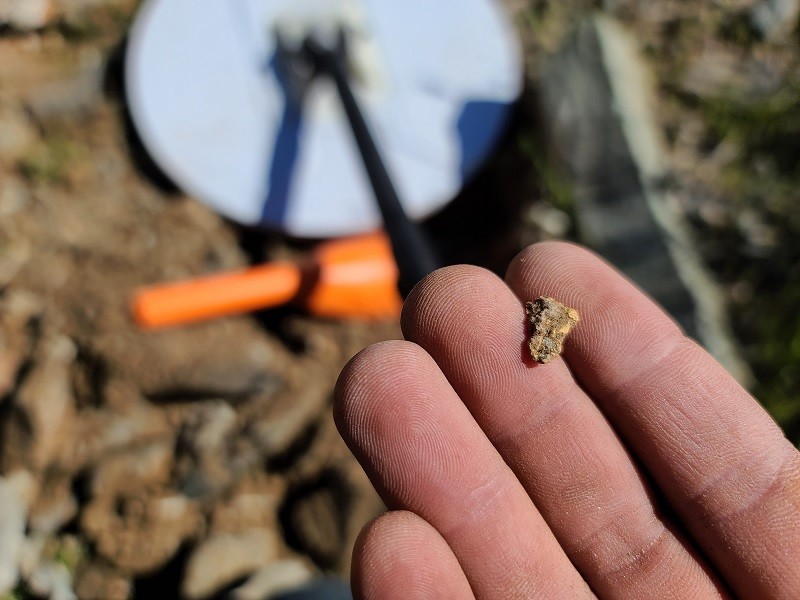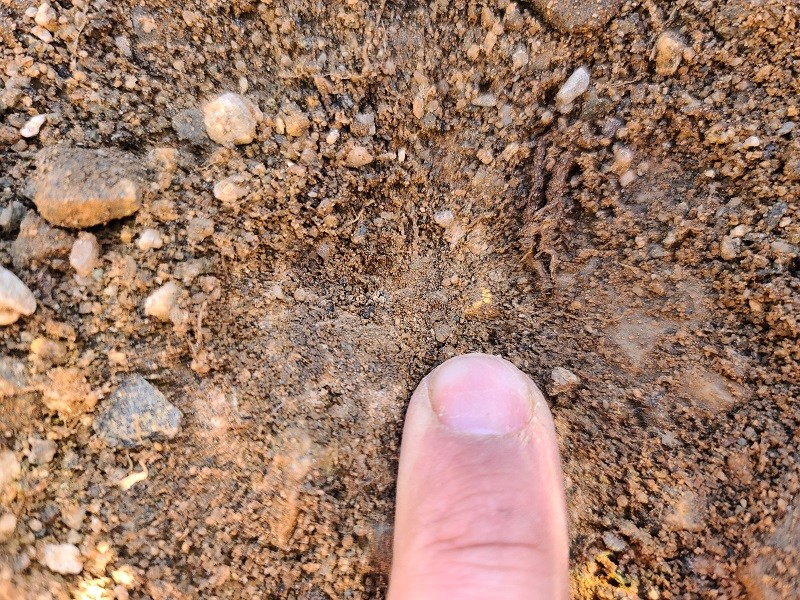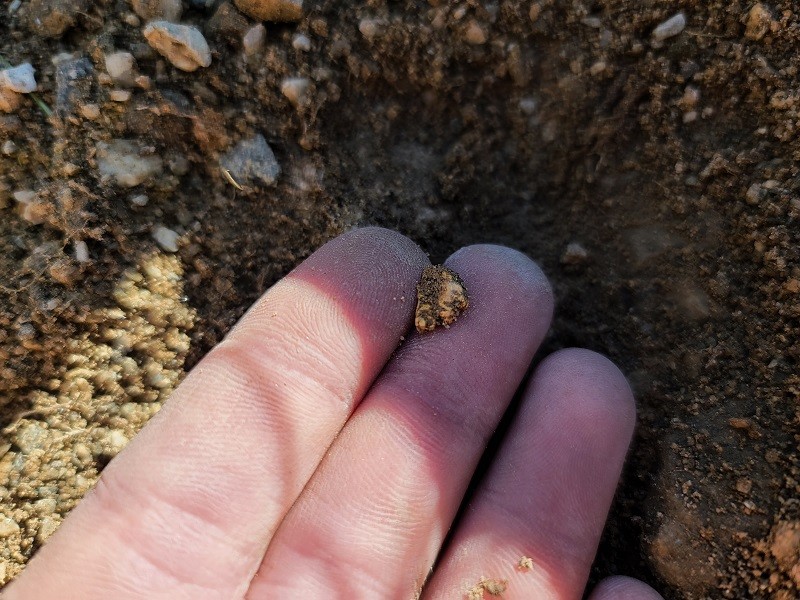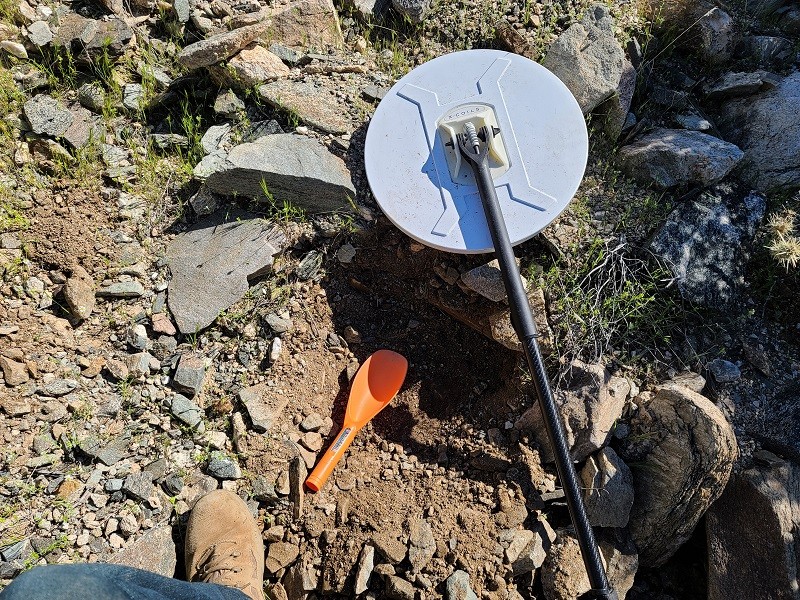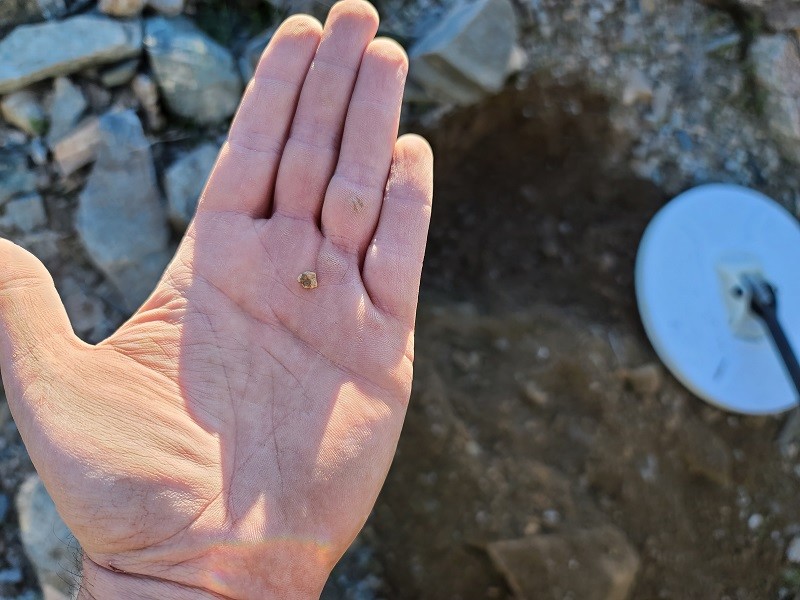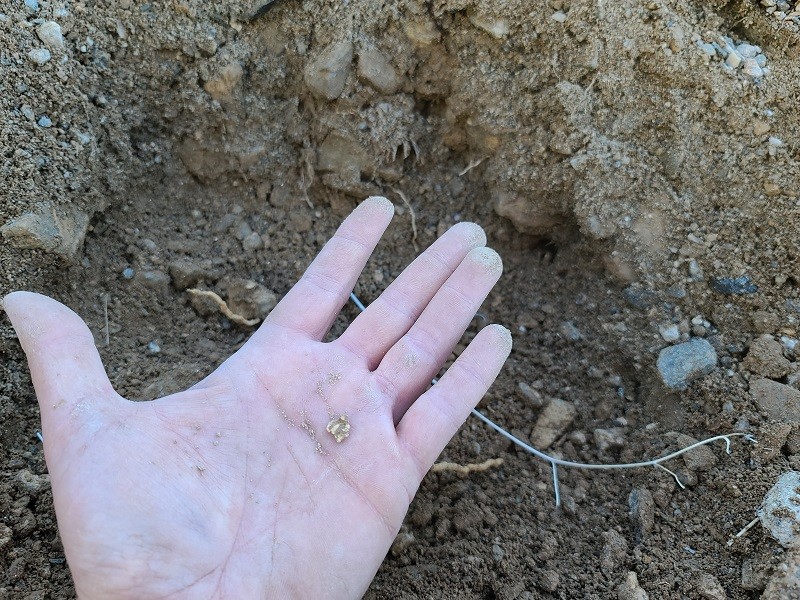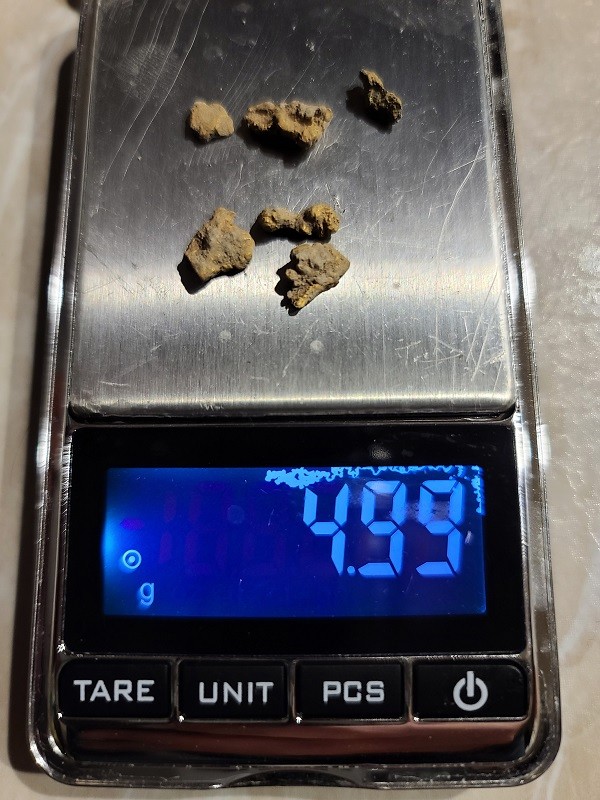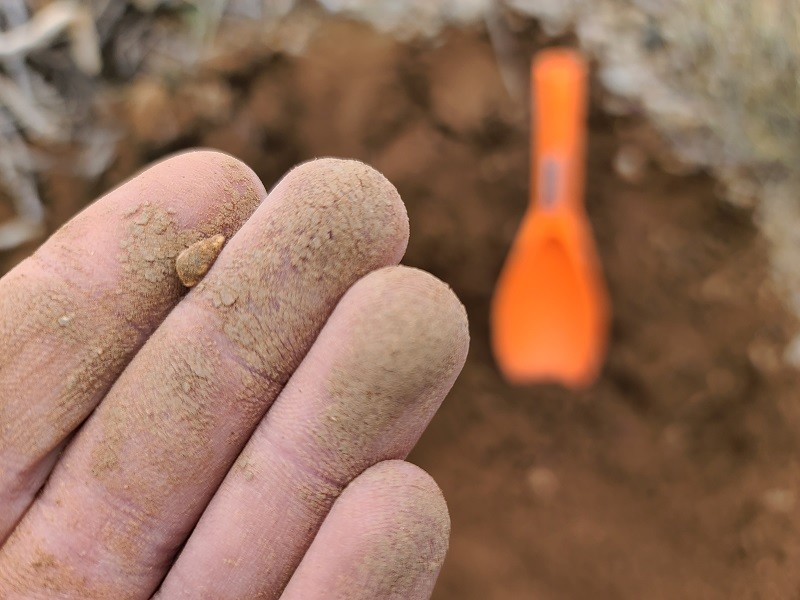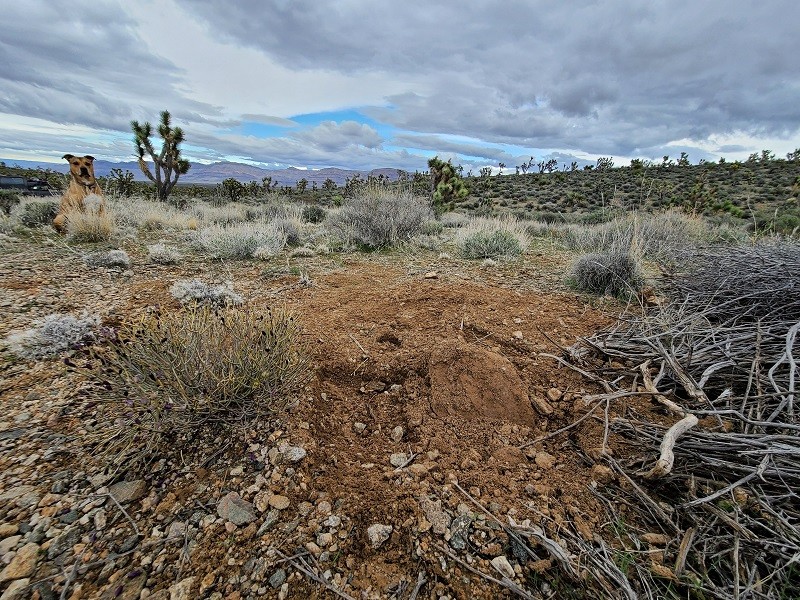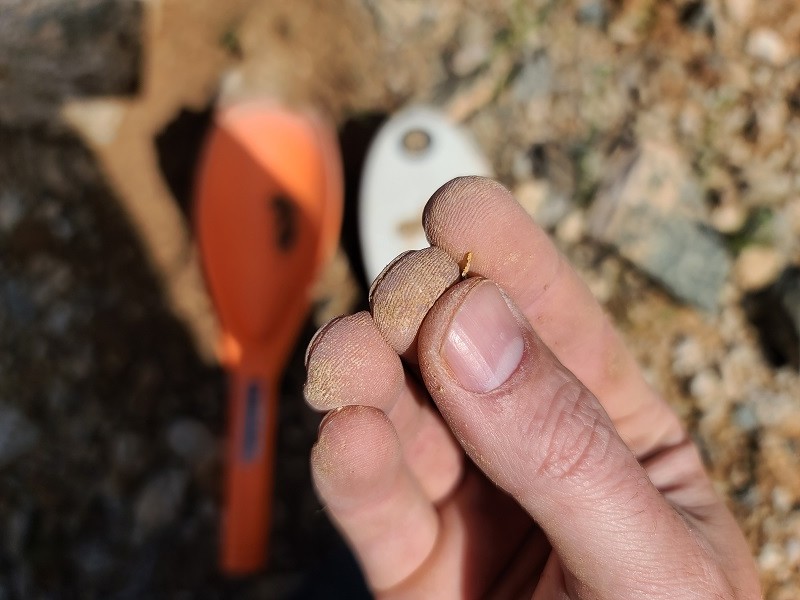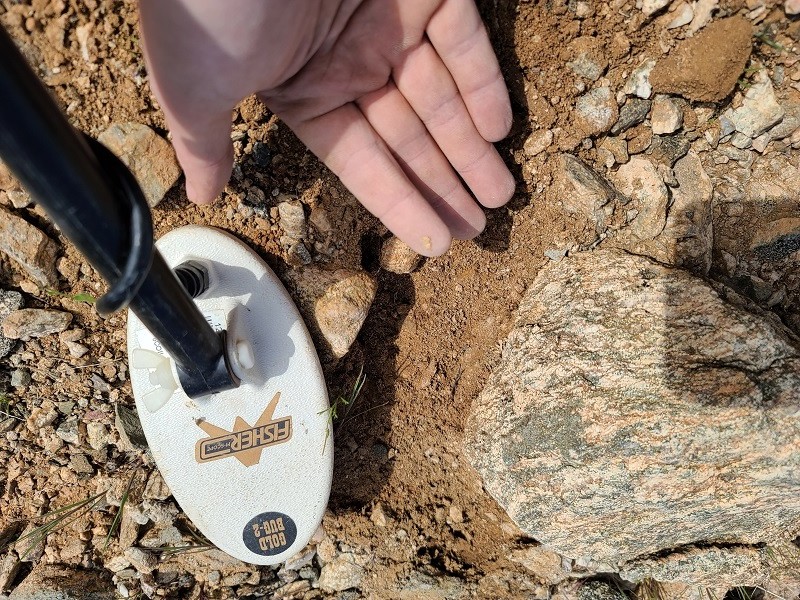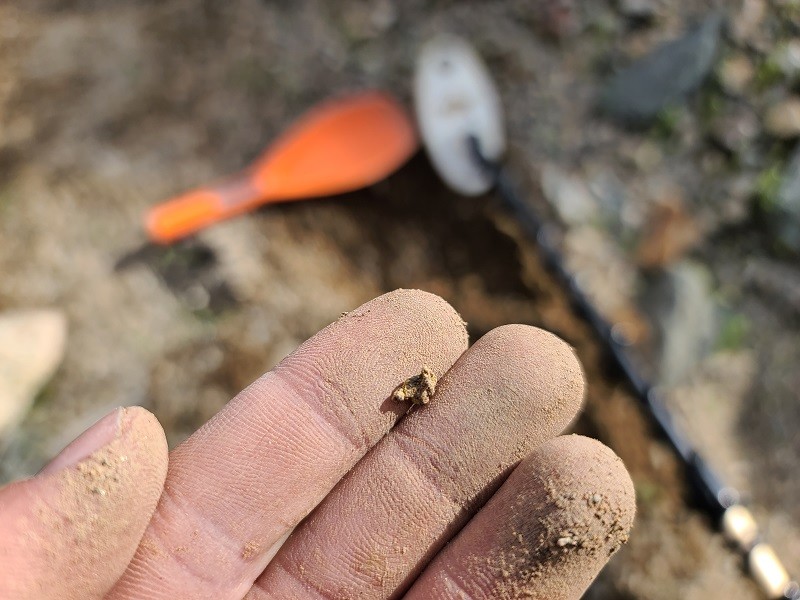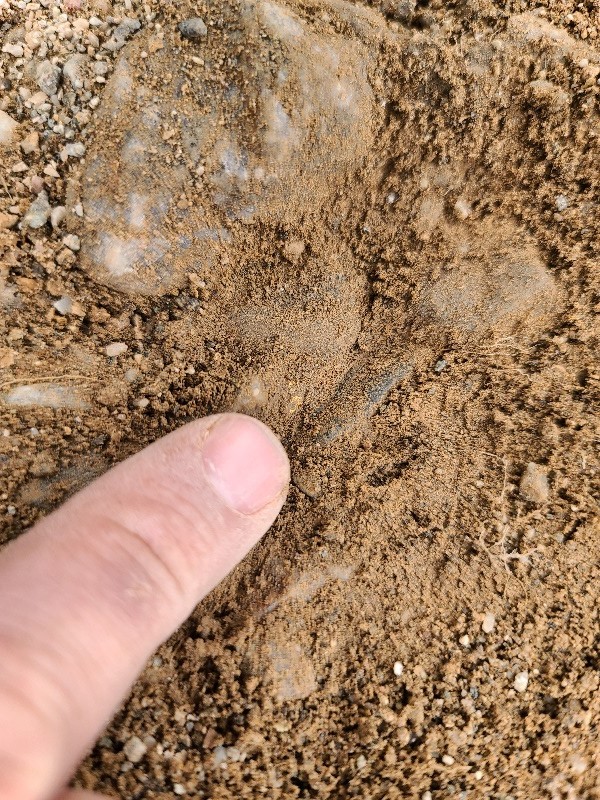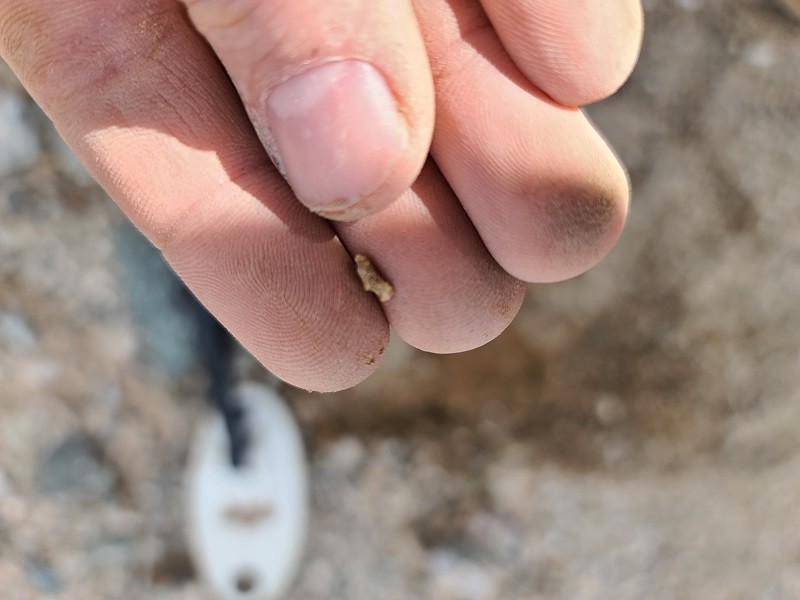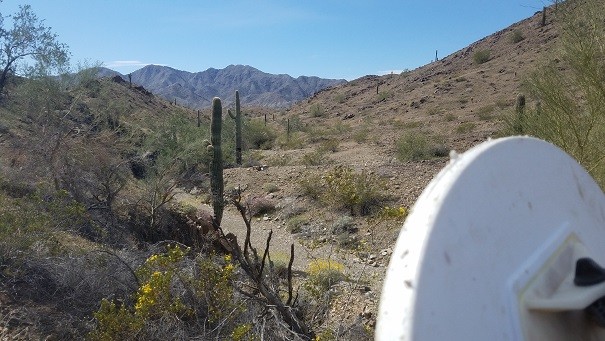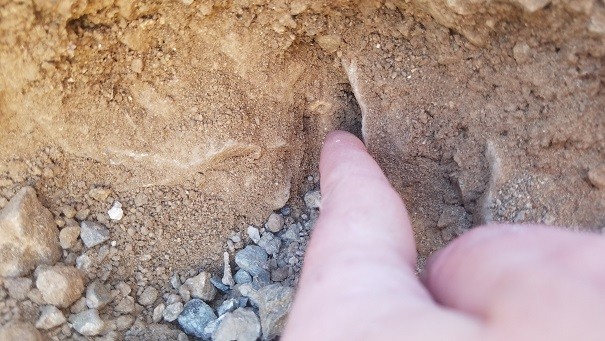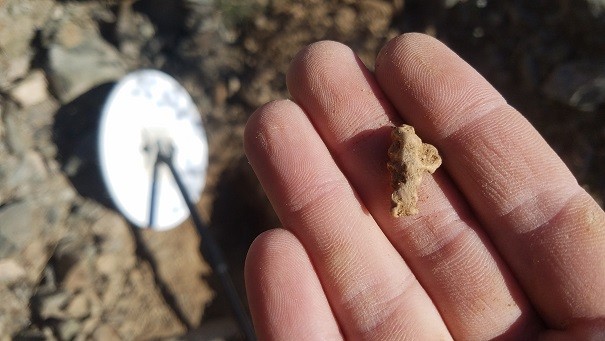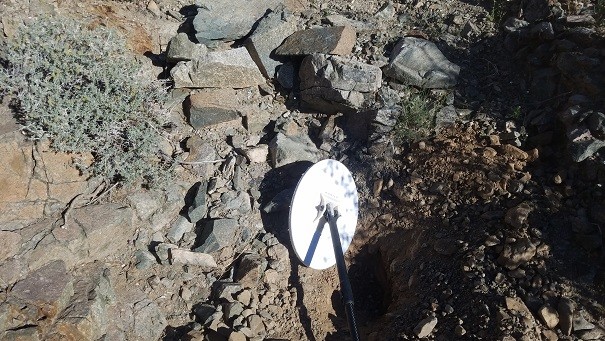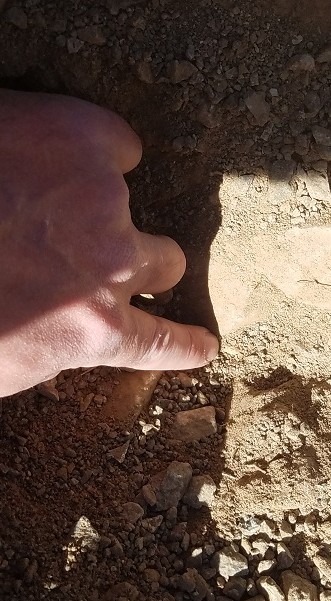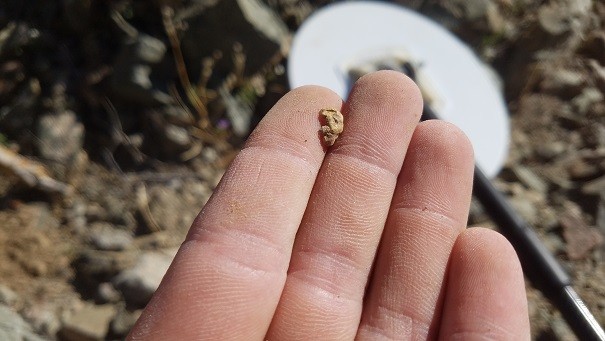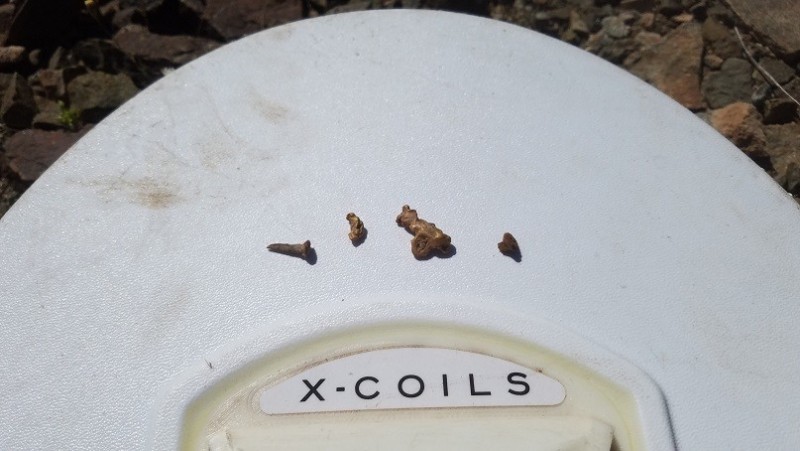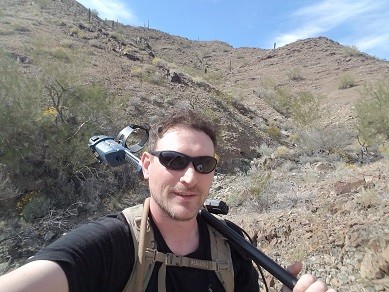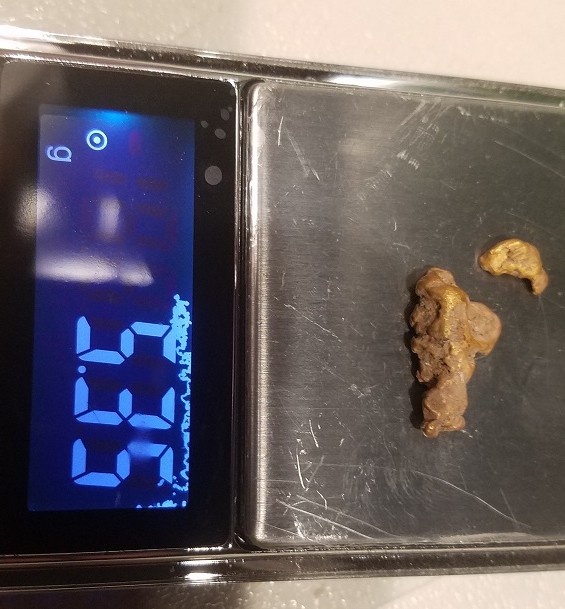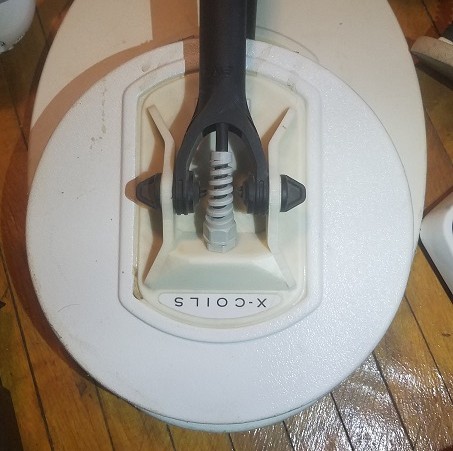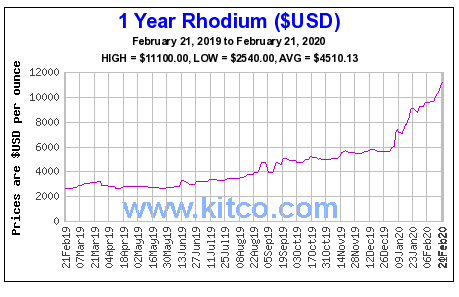-
Posts
2,465 -
Joined
-
Last visited
Content Type
Forums
Detector Prospector Home
Detector Database
Downloads
Everything posted by jasong
-

X Coils In Gb, Scrounging For Missed Nugs
jasong replied to jasong's topic in Detector Prospector Forum
I have to head home soon. I am a bit short on photos because it's been 50 degrees, 20-30mph winds, and constant drizzle. It makes me just want to stick to detecting and get through the day without messing around. There is no one around, the few people camped out are staying inside. As Condor and Flak have said already - prospecting is social distancing to the extreme and I love it! And it reminds of how it was when I first came here and I had the winters all to myself since everyone else went south. And every so often the sun comes out. The desert is green everywhere now, and I can hear this vegetation and the wet patches on my 17" coil so I'm having to slow myself down a bit the last few days. Notice I've removed my protective cover from GPZ, it's too much of a hassle with constant coil changing. Plus it's a tool, tools get beat up. whenever I sell this machine, the battle scars will be an testament to the machine's successes for whoever the next owner is. A mockingbird visited, bouncing up and down and making cricket noises, coyote howls, rooster crows, dove calls, I'm pretty sure it was trying to emulate an ATV engine sound too. First one I've seen and it was pretty amazing. I also noticed on the way in that someone has begin to detect my area pretty hard, and systematically. I noticed this on a number of other areas as well. Back on topic, my plan was to hike to a 2nd wash which had produced well for me in the past. It's about a 30 minute hike in, and I took the 17" with me to run over the rocks and do some deep seeking. I've worked this wash over 6-8 times with the Z14 because it's near other areas I was exploring and I'd always stop by on my hike back to grab a couple more nuggets on slim days. I've also run my GB2 over it once. This wash is getting really slim on targets. I had been running for a couple hours and began to think my "gas money wash" was pretty much dead. But then like last trip, I got a slight signal above a big pile of rocks. Pulling the rocks aside, the signal turned into a screamer and I knew it had to be gold. About 6" of rocks and about 10" of soil removed, I popped out a 2 grammer after using my flathead to chisel through about 1" of rotten, soft caliche. 30 minutes later I found a dink, with a lot of crystalline limonite and quartz, right in the middle of the wash, about 6" deep. The brown is attached caliche, not part of the nugget. And another 2 hours of poking and prodding, trying deep areas, produced nothing further. As new equipment comes out, this will be a great testing ground, if something new can make this wash produce more then I'll be personally impressed. Total take was 2.62 grams, again a paying trip. I cleaned these nuggets in water so you can get a sense of the porosity and inclusions. Under a loupe there are hundreds of tiny grains of quartz embedded into this stuff along with a crystalline form of limonite which often resists HCl. But I wasn't done yet, as the drizzle started again I hiked back to my truck and decided to take advantage of the 17" coverage by prospecting a hillside I suspect had gold somewhere on it since all the nuggets I found in the wash were on one specific side, and not on all stuck in caliche yet, indicating they had moved recently. One last post soon... -
Probably about 80% for me. But it's not going to continue, too much population too close to the goldfields here in the US means virgin ground is almost non existent today. That's why I'm concentrating more on finding and selling large scale hard rock prospects to companies now, almost no prospectors do this here in the US and so my competition is basically non existent. I believe this is the only way to actually make money prospecting in the US today. Without a doubt though, for raw production, there is no substitute for working virgin ground, if a person can find it. There are some borderline case patches from 4500/5000 days which I found right in flogged areas because people (including detecting veterans) were insisting online about running in Fine Gold and very low gains in mild ground with deep bigger nuggets, as was the advice on the US forums back then. It was "flogged ground", but not really flogged. That said, I just found a mini-patch this week that my 17X was definitely the first over. Nothing amazing, but they are still out there , even though I really not too fond of that phrase these days here in the US.
-

X Coils In Gb, Scrounging For Missed Nugs
jasong replied to jasong's topic in Detector Prospector Forum
I hear you Flak, I'll be eagerly trying one of the NF offerings out next year too. They look thinner and even lighter than the X Coils from the early photos. I'm down with whatever product works the best. I will say, I hope NF keyed into Chet's cable mod and make their coil cables like that. When you switch coils out 3 or 4 times every day it becomes clear that the GPZ wasn't really designed for a lot of coil changing what with where the connector is located and the clunky design of the control box opening mechanism. So much nicer the way Chet has his set up. Aww man, don't make me blush. I am definitely not high on the respect rung in the local AZ detecting community as a lot of people here actually dislike me quite a bit, but I appreciate the compliment. I'll try to put together one last post here in this thread tomorrow of what else I found with the 17" in Gold Basin. My success with it has continued. I wish I had some kind of critical input on it to recommend improvements, but it's a great coil all around, as long as one isn't in alkaline/salty soil. -
Exactly this. I've made a lot more money prospecting for and selling minerals and gold to companies than I've made or ever will make detecting for nuggets. What is important to me is to know "is there gold here, where is it, what does it look like, and in what general quantities", I don't need to find every piece to learn that. I've barely found 4lbs of gold with a detector in my life, that is nowhere close to enough for me to live off. But detectable gold is a great way to trace eroded away or hidden high grade structures, and these are what I really look for today. That knowledge is valuable to me. I do detect for fun though too. Like these trips I'm posting about. And when I move fast, I find a lot of areas I can revisit later, which are great for as you say paying gas by cleaning up the missed bits. These are the trips I try to make 2 grams minimum a day, to pay for gas and food, and I always seem to find more when I cover more ground vs slowing down and trying to clean up crumbs. I adopted a "brute force" method when I started since I knew no one to help learn or share locations, which was basically just systematically covering every possible bit of ground and observing the geology and signs of human activity around me until I figured out what to do just by sheer amount of ground covered alone. It's not unusual for me to walk 4-6 miles a day when I look at my GPS tracks. It's not possible to cover that much ground with extreme accuracy, so I don't sweat the small stuff. I am comfortable that I get the majority of gold I need to get the information I am after. Thanks for the information on Volume, I'll give your advice a try next time I am at one of my washes I just hit and see how it goes.
-

X Coils In Gb, Scrounging For Missed Nugs
jasong replied to jasong's topic in Detector Prospector Forum
Time to strap on the 17". I was given this coil free by the manufacturer. I think I've made it pretty clear at this point that my opinions are my own and I'm not afraid to say exactly what I think though, even if it's not something people want to hear. But first, here's a great view of an arm of Lake Mead from the top of the Lost Basin range, my land is about 10 miles to the left. I love this area, it's stark and rough and beautiful. A few spots in the US really give me a sense of peace and being...San Juans in CO, Wind Rivers in WY, and Gold Basin here in AZ. It used to be solitary too but that's slowly changing, still not much development out here yet though. Vegas is behind the mountains in the distance. Almost all cacti species are native to the Americas, aside from a couple rare outliers. This one is a cholla, and I hate them so very, very much. Those who prospect in AZ know why, especially if you have a dog or like putting your hand on the ground to stabilize yourself. Joshua Trees are more noble, and they only poke your eyeballs out if you don't wear glasses. Back to detecting. I decided to go with the 17" after determining I wasn't getting much advantage running the 17x12, and knowing from past experience how deep the washes were that I planned to hit and that I hadn't found much under 1/4 gram in the past so I didn't want the 10X here. These are 2 "patches", or really just washes, which I found myself and was clearly the first and only coil over. One wash produced about 4 ounces, including a 29 grammer, 19 grammer, and a 12 grammer, two 7 grammers, all deep. The other wash produced about 1.5 ounces of mostly 1/2 gram to 2 gram pieces. I detected each of these washes 6-8 times with the GPZ/Z14, and one of them I found in 2014 and had hit with my 4500 and 17x11, 14x9, and 18" round. As you can see, it's not the type of ground anyone would normally use a 17" round in. Rocky. I felt as if there were no diggable signals left with the Z14, so they were good places to start with the 17" to guage performance. I ran the same settings as I used with the Z14 and I keep a record of all my finds and my settings on Google Earth for future reference - 18 gain, 12 thold, low smoothing, HY, Normal. There are BIF and magnetite chunks here, and a lot of places get pockets of black sand which make the wash bottom hot. But I still classify this as mild conditions. The 17" really isn't a whole lot bigger than the Z14 when it comes down to it, and I can still nose it into the rocks, and glide over them. Ideal? Not at all. Did it work? Yes. Within 10 minutes of poking, prodding, and gliding over rocks, I had a nice signal. Not subtle, but very clear and repeatable. And it was literally right within view of a place I have in a video with no signals on the Z14. I'm confident I hadn't heard this one before. Kicking rocks out of the way and then digging through about 12" of dirt, I pulled out a 1 grammer. It's towards the bottom of my fingers in the middle of my hand if you look close. And about 5 feet further up the wash and to the side I got another great signal, unmistakable and in a place I've hit with the Z14 numerous times. Another 1 grammer with lots of hematite and quartz. And again, 15 or 20 feet further up, and under a pile of rocks and 10" or so deep, I get another one. Caught this in situ as it was wedged into caliche. Pulled it out, this time it was 1.5 grams or so, I forgot the exact weight. Between the dirt depth and the stack of small boulders that was sitting on top of it, it was probably 14-16" or so down. The stack of rocks on top had surely hidden it just an inch or so out of range of the Z14, but the 17" round was able to ping it. Here is the hole, the rocks I tossed off the top are out of the photo, but it was like a little waterfall of 10"-16" rocks that were high enough to just put this target out of range previously. A smaller coil wouldn't have helped because there was no open spaces to shove the coil into, it was the larger coil with greater depth that was able to hear this nugget under the rock pile that succeeded. Most of the targets I was finding seemed to be getting hit like this. I know it looks like the Z14 should have hit a target like this, and I feel the same way, but somehow over multiple passes I never heard these targets. This was maybe 1 hour of detecting so far. And I was thinking at this point I was going to pull an ounce out of this "dead" wash at this rate. But that's where everything dried up. The wash flattened out, the big rocks decreased, and I didn't find much else for another hour or so until I pinged anothe 1 grammer about 10" deep. No idea why I didn't hear this on my Z14 on prior passes, it was a great signal. I believe it was standing vertically though. Finally when it was getting close to the time to hike back to my truck, I hit one more umistakable signal. Here's what it sounded like after a small bootscrape for those wondering what the signals sound like on the 17" which the Z14 couldn't hear at all. Solid, repeatable, and a definite dig me. These X Coils sharpen up signals to me a lot. This signal was more or less near the center of the wash, in a flat area that I must have detected 6 or 8 times with the Z14, no chance I didn't run over this since the wash is only 5 or 6 ft wide at this spot. This coil is just getting an extra 1-2" of depth on 1 grammer type stuff and if you find a spot that has a lot of nuggets left in that additional sweet spot, success will follow. Washes without that magic formula produce little to nothing. And here is the nugget which was making that signal. It was about 13-14" deep and sitting right on caliche. And the total take for the day, almost 5 grams of missed nuggets. This is a profitable day for me, I try to make 2 grams minimum average per day when I'm on a detecting trip. More washes like this would pay to revisit, so I tried again the next day on a 2nd wash, and I'll make another short post on that. Overall, I'm impressed with the 17". Prior to this, I had used it only in wide open, flat areas. But I figured why not give it a go in a rocky wash where there was a history of larger, deeper stuff. This is where it REALLY helps to be the one who first found the wash, and who knows exactly what type of gold was found and how deep, otherwise I'd waste my time and my arm strength running a coil like this over random rocky washes for no reason. This is why people who were around in the early days have such a large advantage of those who started later, and it's hard to truly understand how large that advantage is until one makes finds in a new area themselves. Anyways, the 17" doesn't feel a whole lot heavier than the Z14, just slightly. I can swing it for a good amount of time without using the guide arm and not get fatigued. This coil to me fulfills the promises of what the Z19 should have been. It's more sensitive than the Z14 even on the 1/4 gram type stuff, and definitely gets up to 2" or so more depth on the 1+ gram stuff. One thing is that this coil is so sensitive that keeping my phone in my upper jacket pocket is no longer possible. And the small metal piece at the bottom of my boot zipper is now really annoying where as it's almost inaudible on my Z14 unless I get close. I really find myself needing a longer shaft on the GPZ with the coil too, for those reasons and also because it doesn't get far enough out from my feet to prevent me from stepping on the coil. I'm only 6ft tall, ML just needs to start making longer shafts for future machines. Also, properly noise cancelling with this coil is essential. It'll pick up EMI like crazy if you detect wash sides, but I was able to mitigate most of that by noise cancelling multiple times through the detecting session. I can get away with once a day with the 12" round, or sometimes forget to noise cancel entirely. No way with this 17". That is to be expected of any big coil though, bigger antenna for EMI. I really have no complaints or suggestions for improvement on this coil at all, it does what I expect it to do and it's definitely got a place in my arsenal now. The edge sensitivity is great, and the coil hits small stuff and deep big stuff alike. This is the first time I've really felt like I'm finding stuff I couldn't have found somehow with my Z14/GB2 combo. I feel most these targets would have been inaudible at any setting on the Z14. -
12, I think? Whatever default volume was, I've never changed it from factory on my 2nd GPZ. My hearing is pretty good and I've never had to use a booster, I still have a ton of volume to go up on the GPZ itself if I needed it, but I've never felt I needed it. Much bigger problem to me is audio fatigue where my brain starts selectively ignoring stuff when there is a too much of a threshold drone and too many spurious signals. Not so much using smoothing as a volume control as a way to make the audio cleaner so I can detect more ground, faster. Not by swinging faster but by concentrating on spending my time digging signals with a high probability of gold, versus spending time digging signals with a much lower probability of being gold or spending time stopping and analyzing signals that are largely just ground noise/EMI. Do I miss stuff? Yes. I am not in the camp that I need to hear the ground under me. I understand it's not PC to say this as most the experienced guys generally say they want to hear how the ground changes under them. My eyes tell me what I need there though and I don't need to know if I'm over hot or mild ground as I move. More important is for me to look at the geology and topography around me. I want a quiet threshold so I can pay attention to the world around me and just have targets jump out at me, it helps me stay on the gold more than listening to wether the ground is varying. I do understand what you mean about the start/stop nature of the threshold, but that's exactly what I'm going for. I like my signals to be sharp and definite, and my threshold to be minimal and in the background. I know I occasionally miss faint threshold variation stuff as a result, but my experience is it pays better to spend time hitting more ground than spending time chasing these types of signals. I've done some experimenting on in-situ targets here where I detect, and I've found a big difference between running at 9 gain and 19 gain. Low gain misses a ton of tiny blips that are to me very definite gold targets in my smoother, but high gain settings. I have some video of almost exactly this somewhere, might be on my computer at home and I'll look when I get back. Turning gain down, but thold up and smoothing off could not not hear a target I had just found with smoothing on, thold around 12, and gain at 20. In the video it ended up being a 7 gram target in the wall of a wash, maybe I have it on my GoPro here, I'll check tonight, I gave up on posting videos last year though and lost track of all the stuff I was going to compile. I've experimented similarly before on in situ targets and it generally shows me the same, higher gain/lower threshold hears things that lower gain and higher threshold/no smoothing miss. Maybe it's just my conditions, maybe it's my lack of skill or lack of patience, but this is what works best for me here.
-

X Coils In Gb, Scrounging For Missed Nugs
jasong replied to jasong's topic in Detector Prospector Forum
Yep, geometry/composition definitely makes all the difference when it comes to the small ones. I tested an invisible dink on the 10" with 24 threshold and smoothing off just to make sure the settings weren't it, and it was still totally inaudible even touching the coil. Yet I can hear a solid piece almost half it's weight 1" away like it's a great signal. It happens with bigger nuggets too, but just not nearly as pronounced. For this porous, quartz laden type gold I found the GB2 generally gets better depth on stuff up to 0.15 to 0.20 grams or so from my rudimentary rebury testing (highly variable depending on geometry and how much quartz/hematite is in it), which is roughly what I was seeing in the field too. As JW and others have shown, the 10" can outperform a VLF on the more solid type of small gold though. Hope you snag some nice ones. I'm looking forward to your post, the best of my success in AZ has come with that coil and I'm curious to see the results from others here in AZ too. -
I put in some serious days of detecting old patches in Gold Basin in order to get a solid idea of what I personally missed with the Z14 and give my coils more of a workout. Most of the spots I hit were patches I personally found and I doubt anyone else has ever detected, that way I can gauge what exactly I was passing by and get a good feel for the differences between the coils I have with me. However, the first patch I hit was on in Lost Basin proper and not one of my own. I had once met an old timer detecting here as I was exploring back in 2014 and he explained he had found this patch in 2002 and it had produced up to a 1.5 oz'er and about 3-4 ounces in total, mostly deep. It's about 50'x50', seen 3 GPZ's I am aware of, 25" coils, and about 2 decades of detecting. I put on the 17x12, which I was given free by the manufacturer, and began a mental gridding. 12 t-hold, low smoothing, 19 gain, HY, Normal. About halfway through I got a very subtle signal, but it was repeatable. I kicked off low smoothing just to hear the difference and the signal was definitely bigger...maybe wider is a better term. Kicking into Difficult the signal disappeared. Back to my normal settings, I boot scraped an inch and saw the top of a large rock which I assumed was the signal, but after pulling it aside with my pick the signal got stronger. I ended up with a solid ~0.3 grammer at about 10 inches. I'm certain this target didn't make a peep on the Z14. You can see the big boss man overseeing the operation here to the upper left, and also the old dead twigs which the old timer had at one time raked aside, which was what drew my attention to the area to investigate at first. Grand Wash cliffs in the background, the Grand Canyon is directly behind them. Visible is the foreground is the filled in hole, you can see this is pretty typical Lost Basin reddish dirt. I would classify it as mild to low-medium "heat". Some run Difficult here, but I see no need for it. Here is a video of the lack of sensitivity at the tips of the 17x12. It's really noticable when trying to pinpoint and oddly it makes a big ole 17" round easier to pinpoint with for me than an elliptical. I feel as if the 17x12 is like detecting with a 14x8 except with a lot of extra plastic around the edges and with the depth in the center of the coil of a 17" elliptical. It's odd. I'm not sure it's my choice for rocky washes anymore because that sensitive area towards the center is hard to get over everything. Next I moved to a wash in Gold Basin which had produced a lot of sub-1 gram stuff for me in the past and I put on the 10" to do some crumbing. I slowed down and really made an effort to listen for tiny blips but after running through about 40 feet of wash bottom without a piece of gold I decided to grab my Gold Bug 2 and run back over the same ground because I swore I should have had some dinks by then. A lot of caliche is exposed here, and for those who don't know what caliche is, it's basically a limestone conglomerate type rock that acts as bedrock in the desert here. It can be soft or hard as concrete. Almost immedietely I had a strong signal on the side of the wash, which I assumed must be a small bit of tin. I grabbed the GPZ/10" and despite my best efforts I couldn't get any type of real signal to repeat for me. Going back to the GB2 I recovered the target and it ended up being a 0.03 gram tiny nugget, which upon looking with a loupe was quite porous and had tiny microscopic bits of quartz within it, a very common occurence for nuggets here as much of the gold forms within breccia in shears and shattered fault gouge here so it often encapsulates almost microscopic bits of quartz. Due to these non-sluggy sort of targets, the VLF seems to hit much harder on them than the GPZ/10", which probably explains why I can't seem to get the sensitivity on my tiny nuggets as others seem to be reporting, even in other parts of AZ. A 0.1 gram nugget of gold from here might only have 0.05 grams of gold in it, and discontinuous geometry, which is hard on non-VLF machines. I moved on another 5 feet and hit another pretty definite target on the GB2, this time it was a paper-thin flake, I think it was about 0.05 grams. Just holding it in my fingers lightly was enough to bend it. It's at the tip of my pointer finger. It would make a sound on the 10" if I waved it in my scoop right over the coil, but it couldn't hit it at about 1", just too thin even for the GPZ, and that's why I missed it I think. I put my GPZ back in the truck and decided to just run through the last 30 feet or so I had covered with the 10" just out of curiosity. I almost immedietely hit another signal, faint but repeatable. At about 6" I pulled out a 0.2 grammer right on caliche. Not sure how I missed this one, might have gone too fast with the 10". It ended up having a lot of quartz too, and some hematite. And then another 5 feet again, about 5" and sitting on caliche, a 0.2 grammer that I really should have heard before but somehow didn't. This one I got in-situ before brushing it away as it was wedged in between two cemented pebbles. And then finally a 0.15 grammer that really wasn't even very deep. Not sure why I missed this one but it was right in the center of the small wash and there is no chance my coil didn't scrub it. This post got kinda long, so I will take a queue from JW and do a multi-part post. My conclusion (unsurprisingly since we already knew this) is that the target geometry/composition makes a big difference in how successful a person is with the 10" and why I was having trouble understanding why people don't simply just go in with their VLF's instead of the 10X since it's so much quicker and lighter. I know I traded notes with Andy when we first got our 10"' X Coils and he was getting a lot better depth on tiny bits than I was, and I'm sure it's because the gold in the areas he detects is more solid and my gold has a ton more quartz inclusions and porosity. I have some 0.1gram bits that won't make a peep on the 10X even running them directly over the coil in my scoop, and that's due to the target characteristics. Overall, I'm reminded why I rarely spend much time doing this kind of detecting unless I really need to get a couple pieces for morale. I don't live close enough to gold fields where I can spend my time chasing small stuff like this. That's just me and my personal situation, but I feel it's necessary to state since the majority of posters here live much closer to detecting ground and might not understand why I detect the ways I do. It's 1000 miles drive each way for me to go detecting and I'm not retired so I have to make it pay or at least break even. Next post I'll show you what I normally aim for in my personal detecting and why I do it that way even though it breaks some of the "golden rules" of gold detecting. I believe it will be important to make these distinctions for those new people reading these sorts of posts 5, 10, 15 years down the road and wondering why we did what we did. I feel it's important to not copy what others do online, but to develop a strategy and skillset that matches your local conditions and personal situations. My style probably might not even be optimum 150 miles away in the Bradshaws, let alone across the country or world.
-
Today I spent 7 hours of detecting with smoothing off, threshold at 24, bumped my gain back to 16 and slowed down to a glacial crawl and scraped or dug every single subtle, semi-repeatable tiny warble in the threshold I could pick up in 2 patches which I had just run the 17x12" and 17" round over. I started thinking all those barely there signals I got tired of messing with previously might have been nuggets after reading JP's thread so it was worth a go with brighter, non processed audio, to see what I missed. I've flogged these spots with the Z14 at least 6-8 times each too, plus a GB2. Originally ran with a thold of 12 and low smoothing on the Z14, as it was my go-to for Gold Basin. I knew there were some iffy signals to investigate. I got about 30 or 40 hotrocks (mostly BIF and magnetite clusters buried 3"+ deep), a lot of small lenses of hot ground and black sand concentrations, a lot of disappearing signals, and I found one 0.17 grammer with quartz in it. That nugget was not audible in the ground on Difficult and I would have missed it if I tried tamping down the hotrock response by moving out of Normal, it sounded just like a barely audible buried BIF chunk. One thing I still know for certain is that kind of detecting still isn't for me. I know it's next level to find the almost non-existant signals and turn them into gold, and I know I could if I wanted to spend the time doing it. But, I believe I can get 95% of the gold in 10% of the time running low smoothing, 8-12 threshold, 18-20 gain, HY, Normal, out here generally and that lets me enjoy the time outdoors more, just my personal preference. The Z really does make signals pop and if you are on the gold and running hot settings, it's going to tell you without much effort or scrutiny required, the X Coils really do seem to sharpen up the responses even more on top of that too. A 10" or 17" X with low smoothing will hit stuff a Z14 with no smoothing can't hear even faintly. No equivocation. I am liking the 17x12 less and less and the 17" spiral round more and more. The 17x12 has a real problem with desensitivity at the ends, to the point that the 17" round is actually easier for me to pinpoint with and covers a ton more ground at greater sensitivity, paradoxically. The form factor of the 17x12 is greatly preferable, but I don't feel as if it's a lot of use when the coil isn't very hot at the ends. Maybe it's just my coil, dunno. I'll post a video tomorrow or sometime to show what I mean. One thing - I cannot for the life of me run in Semi Auto with these X Coils out here, only full Auto. Otherwise I'm digging hot rocks every 2-5 feet. This is ground that I wouldn't call it exactly normal to dig more than 4 or 5 hotrocks a day in detecting normally. Ground is quiet though and it will balance fine. Another observation - I haven't had a single "zed warble" target with the X Coils yet, not even trash, which is just an oddity and not a bug. Might just be my targets.
-

Jp’s Audio Visual Gold Thread
jasong replied to Jonathan Porter's topic in Detector Prospector Forum
Chasing those kinds of signals, how do you not end up with a boot scrape every 10 inches? -

Gold Tops U.S. $1600 For First Time In 7 Years
jasong replied to Steve Herschbach's topic in Detector Prospector Forum
I think uncertainty regarding the solvency of our financial system and currency causes gold to go up. Uncertainty about wether or not a family has the cash on hand to buy the things they need while weathering out a storm probably causes cash to be king. My best guess anyways, what we are seeing now isn't like market pullbacks of past, thus the seemingly odd performance of gold. -
JP, an easy way is to start a YouTube account and upload your video or audio there. Its free, fast, and unlimited bandwidth. Then just copy and paste the link and the forum will automatically recognize it as media and embed the video into your post. I think you need to paste the full video URL (youtube.com) and not the link shortened one it gives you for the forum to recognize it though. Bonus is you can make a bit of income posting videos too if you get above 10,000 subs or so. The avoiding small bits of wire and tin via using extra deep kinda works. You'll hit some small trash but it cuts some out too. Its like using salt coarse timing on a 4500 in the Chemehuevis to avoid the tiny wire bits from the WW2 target practice,which was the only way I ever had enough patience to detect out there.
-
Bill - regarding salt in wet soils in NNV, I haven't run this coil up there yet. But my feeling after running it over a patch of heavily alkaline soil in Gold Basin which I also ran the Z14 over is that it's more or less equal with regards to salt response, if not a little noisier on salt. But it's also more sensitive to tiny bits of gold. Sort of the snake eating it's tail, we can't have more sensitivity to gold without gaining sensitivity to salt since they are both conductive. I have business in Wyoming which requires me to cut my trip short, but if that changes then I will try to stop in NNV for a week on my drive home, and I have the 17x12, 10", and 17" round with me which I can test out. I'd be curious how the 10" does up there. JP - I definitely agree with regards to smoothing. However, I'll be the first to admit I detect lazily in general, I usually sacrifice a bit of accuracy in order to improve speed, especially in cases like this trip where I only have a few hours to detect. I can bump up sensitivity in this mild soil with zero ill effects so it was no prob running 20, I mostly just want to smooth out any noise because my brain gets easily distracted and wants to slow down and investigate every single subtle break in the t-hold. I'd have to kick back gain to like 5 or something to get a similar smooth threshold and I feel I get better performance by using low smoothing instead. If filtering out all of that noise means I miss a couple extremely subtle or complex gold signals then I generally accept those losses in return for being able to cover more ground. I'm definitely not recommending this for anyone, I just use it when the losses are acceptable to me. I know patch cleaning requires running with no smoothing to really pick up the subtle signals, and there is definitely a time for that. For some, that time is always. But in the case of a long stretch of wash and small amounts of time, often I just want to hear the absolute, unmistakable signals in order to spend my usually limited time wisely. To me the perfect detector is just entirely silent, always, on everything except gold. You would hate me if you heard how low I run my threshold sometimes in conjunction with low smoothing, by choice. I know it goes against everything I should be doing, but that's my general style I guess - I also rarely keep my coil absolutely flat, I'm often poking, prodding, angling, and doing anything I can to get a signal to change in some fashion so I can hear if it's worth digging or not. I'm sure that causes me to lose gold as well as I ignore some signals I should dig. I am the opposite of textbook detecting in many respects, but somehow it works for me. However, I do fully agree with what you are saying that some nice, subtle gold signals will never break through the threshold at all if one is running smoothing, no matter how high the gain. When I'm really working a patch and not just out and about or exploring, even though it tests my patience, my threshold rarely goes below 24 and I run in no smoothing. Largely a result of reading your posts early on during the release of the GPZ in 2015, going out and trying to replicate what you said, and seeing the difference in front of me.
-
Thanks everyone! Definitely need to take a full trip down there at some point with the Z+X. I have a few other spots I haven't visited since 4500 days, but they will require a full day of driving/hiking/detecting. Unfortunately a lot of old areas I found good gold in have new claims over them now there though. Phrunt - not sure about the spiral vs bundle and the edge sensitivity, but that might be what's going on. However, I know when I was running my 12" spiral wound coil in the washes though that it seemed a lot more sensitive along the outer edges than the 17x12 elliptical does. My 17" round is spiral wound too and it's pretty sensitive along the outer rim, it'll tag 0.1 grammers no problem out there. If that bedrock stuff was the bulk of my detecting I'd probably lean towards the 10" or 12" rounds just because they seem more sensitive on the edges. I should have tested a few targets over Mitchel's 15x10 when he was here to see what sort of hot spot pattern it has compared to the 17x12.
-
I was in Quartzsite looking for flea markets for 2 days with my girlfriend (she is not a fan of prospecting). I snuck off for 2 hours to do some detecting with the 17x12 X Coil which Al had given to me for free to make up for the problems I had with the early X cords. I've not had any issue with cords since then, they stretched again but not enough to bind up in the shaft and inserting/removing coils has been easy now. Since time was slim I decided to hit a wash fairly close to town which had produced a little over 1 ounce for me with the 4500 and GMT, but which I had not visited with the GPZ at all yet. I figured it was the best chance for me to find a nugget in a short amount of time. Most of the gold found previously was 1/2 gram to 2 grams here. Not much smaller, and not much bigger. The wash has bedrock from surface to about 3 feet deep, a nice quiet gneiss and schist assemblage, pretty standard in Q. Part of the reason for the mild soils. I also thought odds were good that I'd missed all the deep, small stuff back in 2012 and that it'd be perfect to clean up with the GPZ/X combo. I'll try something different this time and I'm going to show the horizons and surrounding land. Anyone who really wants to track it down and find it, go for it. As I detect less and less, someone new or just starting can figure out where they are at. This is looking down towards some mountains that can be ID'ed. The part of the wash that produces gold is about 1/2 mile hike uphill from here, and is currently unclaimed. The 17x12 ran even quieter here than in Gold Basin, no problem running at 20 gain, HY, Normal. Though I run in low smoothing because I like a stabler threshold than most so I can move faster and concentrate. Within 5 minutes of hiking to my spot, I got a decent signal, a bit quiet but repeatable. Mostly only sounded off in a circular area under the coil, as if the coil were an 8" round, and I couldn't hear it towards the ends of the coil. I scraped 2 inches of gravel away with my boot, and the signal was now pretty stout. After breaking out the pick, I got down about 15" and started exposing jagged bedrock. I put the coil on edge and pinpointed the signal to a small area between bedrock juts and then began chiseling and brushing away gravel until I found the nugget with my pinpointer, so I could get a picture in situ. It's at the point of my finger inside a crack that required screwdriver excavation. I pried the nugget out of the crack after fidgeting with the bedrock a bit, and was a bit surprised to see it was larger than expected, in fact this is largest nugget I've found in this wash. I figured it was 3.5 grams by feel. It ended up running around 4.5 grams and paid for all our gas and food for the 2 day trip down. So I was happy, for what was at the time about 15 minutes total into the short time I had to detect on this trip. The hole is at the bottom of my coil. The nugget was wedged down in that bedrock which is unfortunately covered in shadows in this photo, and the total depth was just shy of the length of the coil, so around 16-17". There is a new ATV trail almost to the point where I started detecting so I can't help but feel at least 1 person has had a Z14 over this wash, but I'm not certain. This nugget was sitting almost vertical, and I suspect that is why it was missed previously and not a screaming signal on the 17x12, though the signal was definitely sharp and unmistakable. Another 30 minutes of poking and prodding into the rocks and bedrock, and I pulled up a deep drywasher nail and a the head of another nail. Both sharp and loud signals right in the gut of the wash that my 4500/GMT combo had missed 7 or 8 years ago. I was near the start of the wash, thus the end of my journey and thinking it was about time to turn around and hike back down. And then I hit my final target on the short hike, a ~1 grammer which was also a sharp and pronounced signal, and also right beneath a stretch of exposed bedrock. It's at the tip of my finger, didn't have to dig around with the screwdriver for this one. Here is the sum total of what I found with about 1 hour of detecting and 1 hour of hiking there and back. This is a wash I detected back in 2012'ish with a range of 4500 coils and my GMT (before I had a GB2), probably 8 or 9 times total. I covered most of the upper portion of the wash that had produced nuggets for me in the past, though I suspect I could pull another 1 or 2 out of there if I tried with the 10". I'm also pretty certain the 10" would have missed the larger, deep nugget, but I can't be absolutely certain. Total weight, not bad for an ~hour of work. And one final horizon shot right where the nugget zone starts, up towards the base of the mountain. For all the internet sleuths and greenhorns who can't find anyone to share locations with them to get them started. Good luck. Enough clues here to find the area for a dedicated individual. Overall I was happy with the 17x12 in the rocky wash/bedrock areas. It ran smoother here than Gold Basin, both dealing with ground mineralization and EMI. GB gives me these zips and zaps that are absent here, and struggles with the BIF and basalt, and it's real hard to run this 17x12 full bore in washes there with high black sand concentrations. The magnetite chunks in Q gave me problems but they do with the Z14 and 4500 too, so nothing new there. The main issue I have is the edges seem to not be sensitive enough on this coil compared to the rounds. So while the geometry allows you to push into tight cracks, you aren't always getting full sensitivity in the depths of the cracks as you would with the 10" round. The shape of the area of maximum sensitivity within the coil is odd. A simple sweep often misses subtle targets unless you are over one of the sweet spots, and the sweet spot doesn't appear to just be a smaller ellipse within the elliptical coil, it's some odd shape with hotspots within itself. That sounds confusing, but I have a hard time explaining it better. I think Condor mentioned it already, but pushing/pumping the coil into tight spots over the center of the coil (if possible) often works better to hear the coupling between very tiny or very weak targets to determine if it's good repeatable or ground mineralization. I've been doing this out in the open in the flats in GB too, especially in areas of high mineralization, to determine what is a good target. One thing is certain, in the US it's mostly about knowing where to go, or knowing someone who knows where to go. Or having exclusive access to land. This shows why. This was found in 2 hours, but only because I was lucky enough to start detecting at a time when a lot of people ran their detectors subpar by copying settings off internet forums, allowing me to find a lot of stuff the others missed. Those days are largely gone since the GPZ levels the playing field today. I couldn't walk into a goldfield I've never been to an expect the same results, it was only my knowledge of what and where I found gold in the past that let me do this. So, don't get discouraged if your results are not the same. A new guy would simply just have to hope to stumble on this place by dumb luck since all the leads are gone now, while I can just hike right to it. So maybe this will help someone new find an "old" place. I don't detect as much as I used to these days as I have other projects going, but Al (X manufacturer) sent me this coil for free to try last year, and I figured it'd be nice to do a write up since I wasn't able to run my GPZ on the commercial project I have going due to EMI interference from the CAT 336. The coil performed great here though, and it was nice to just get out and finally do some detecting for fun.
-
I just found a new BLM product called S1 Mobile Mapper for Android which looks interesting, although their map selection is slim right now. In AZ they have almost nothing. I downloaded an Oregon BLM map to see how the app worked, and it does pretty much replicate a paper BLM map, though humorously - without trail names like the paper maps have! You can also check the BLM's map/data browser here. Though I think it lacks trail names too. And then their downloadable data is here. If you have a GIS program, you might be able to create the road/trail data from this file I'm unsure if it has road names though as I don't have QGIS on the computer I'm on. *Actually, I take it back, I am looking at the map now with the KML link and it's really incomplete, only some areas have roads/trails mapped. It's weird how incomplete all these BLM files are. I'd go through it and see what I could find but this stuff is relatively new and I'm only now just finding it, and my girlfriend is arriving in a few hours for a week vacation so I'll be travelling around for a while. Someone might dig through and find something useful though.
-
Nice to meet you. If I see you again I'll drive you out to a few old patches. The key to finding peripheral gold around old fields in NW Arizona is to look for 3 things on aerial imagery. This is how I narrow down a massive area to a few specific targets. This is specific to this part of the Mohave desert. 1.) Wash gradient 2.) Soil composition and age 3.) Areas draining metamorphic terrains with felsic intrusions Sounds cheesy, but there is something that I call a "magic gradient". Too steep and the rains flush out the gold, too shallow and the wash chokes off with sediment and gets too deep. The gradient of the washes coming off my land is the Goldilocks zone, so to speak, so it's a real life example of what to look for. Each goldfield has a perfect gradient that varies by amount of rain, bedrock type, sand/clay amounts, and cobble geometry/composition. A rule of thumb is I try to concentrate on areas where the wash bottoms appear to be 1ft to 4ft wide as that also seems to be a width sweet spot related to the gradient and water flow. In NW AZ in general, the hill/slope soils derived from the more felsic (quartz/feldspar rich) intrusive areas tend to hold the most nuggets. They will have a lighter gray look at the suface, and can often be picked out on aerials. The dirt might be red, brown, or gray, but the gravel on surface seen on aerials is usually lighter colored (there are exceptions). The nuggety gold seems to have come during and after the mid-tertiary volcanic activity here. So, gravels younger than the volcanic intrusives are the best bet. If you see gravels with a lot of basalt sitting right on top, the gold often will be very slim and spread out since it's older or equal age to the volcanics. Geologic maps often differentiate between the early, mid, and late tertiary gravels and the quaternary age stuff, narrowing your search down substantially. Generally gravels older than 10 million years aren't worth wasting time on. Younger/modern gravels must be reworking sweet spot gravels to be carrying gold (or draining lode areas actively shedding gold), otherwise they too are often barren. The more modern reddish gravels usually only hold gold when they are reworking/draining older gravels or have modern pockets eroding out right into them. In Lost Basin however, the red gravels often hold the best gold since the drainage up there is probably younger, and was tilted more than GB, causing more reworking. The reason for this, I believe anyways, is partly because GB is underlain by rare low angle faults, LB is at the edge of a normal fault. A lot of the caliche here is derived from calcite in the intrusive units that tend to carry gold, so coincidentally gold is often located where more caliche is, not just because it acts as bedrock. The two are intertwined I guess. Caliche can also be derived from nearby calcareous sedimentary formations too though, as a red herring. There are always exceptions, but this is what I look for when I scout new areas. Put them all together and often you can narrow your search in a new area down to 5 or 6 high potential washes as pathfinders. Hope that helps a bit in your branching out/exploration! You are right though, there is no substitute for knowing people that know where the gold once was. Once the leads are gone, they are gone forever.
-

Nugget Shooter's Field Guide Reviews
jasong replied to DigsAlot's topic in Detector Prospector Forum
I have to ask at risk of sounding ignorant here - who is Reese Townes? I assume someone with a lot of experience since Rob funded the book...? Does he have noteworthy credentials/accomplishments in the prospecting world? -
T/R/S and 1/4 1/4 sections. There is a "generate KML" link towards the bottom. https://gis.blm.gov/arcgis/rest/services/Cadastral/BLM_Natl_PLSS_CadNSDI/MapServer Land ownership (BLM, NFS, USBR, Reservations, Private, etc). Generate KML link also at the bottom of the page. https://gis.blm.gov/arcgis/rest/services/lands/BLM_Natl_SMA_Cached_with_PriUnk/MapServer You can also get on the BLM's list to access their claims database directly and create your own claims KMZ files if you want. Though it's a lot more complex to do and there is no simple link to click. I am not aware of any road maps the BLM offers though. Earthpoint lets you network link topo maps through Google Earth. http://www.earthpoint.us/Default.ashx?RequestID=2rk3Br2PTEySaXar6SjKCQ&
-
I am now sure of two things - 1.) The flogged patches here are much more flogged than overseas patches which people post great results from. 2.) Even getting up to 3" or so extra depth from a new coil still isn't enough to rejuvinate most old, flogged patches here in the US. Mitchel saw me at my land and drove in to introduce himself a few days ago. I tried explaining how to find a few old flogged patches (ones which hadn't seen an X Coil yet), not sure if he ever made it as it's kinda hard without drawing a map. Hopefully he had better luck than I've had, but almost without exception I max out at 1 or 2 missed dinks per patch, max. Many of these patches have seen 30 or 40 GPZs and 5 decades of every detector and coil type on the planet. I just can't help but feel these aren't the types of flogged patches that overseas people are posting 10 new missed nuggets a day from by putting a new coil on.
-
Coverage, sensitivity, and poking that nose into places. The 17x12 is actually skinnier up front at the nose than the 10" is, so I keep it on even in rocky washes, while retaining the depth advantage too. It's the coil I use 95% of the time now. I've said it before, but I can't say it enough, it's the perfect size coil IMO. If a guy happened to be testing a new detector at some undetermined time in the future, it would be a great recommendation to the company for a new stock coil size. (A longer shaft is definitely needed though)
-

How Did The Old Timers Learn What Rocks Had Gold?
jasong replied to tvanwho's topic in Detector Prospector Forum
There is a billionaire oil prospector here in Wyoming. There are only two streets at his company headquarters building. They are named "Guts" and "Luck". In the US, the written history of many major mining districts seems to always start with a cowboy, homesteader, soldier, hunting party, etc making a random find. Or a party travelling from one place to another (or getting lost) and stumbling upon something obvious along the way like visible gold or visible copper staining. After which the actual prospectors would descend on an area and expand it. Hard work certainly played a big part, but often great finds in the US initially seemed to be just sheer luck as well. Geology as a pure science in the 1700's was kinda just one dude in Scotland. Plate tectonics, a major foundation of modern geology, wasn't even really accepted until the 1960's. Rather than hardcore research and cold science - from what I've read of districts I studied - most prospectors chased chance/luck discoveries being made by other people, hence all the boom/bust mining towns that went from 10,000 to 10 people overnight. Assaying, mortar/pestle, and gold pans have existed for a long time though. They talk about it in De Re Metallica as Clay Diggings brought up. But the cold finds made by prospectors setting out methodically to employ these methods in completely unknown/undiscovered districts in the US seem to be far more rare than the camp chef stumbling onto a ledge of gold by accident. Who knows how much is fable or fact I guess. -

Gold Tops U.S. $1600 For First Time In 7 Years
jasong replied to Steve Herschbach's topic in Detector Prospector Forum
The gold prices are nice, but rhodium is dwarfing all the metal gains, it's almost quintupled in the last year. PGM prospecting is looking pretty dang appealing again now. -
Nice work, you are definitely a gold magnet Chris, I got a feeling you'll be onto another pocket next year too! Heck, there is still time left this winter.
-

Parker Finds Large Gold Nuggets In Australia!
jasong replied to mn90403's topic in Detector Prospector Forum
That's better than the US production companies offer (usually zero), I get one contacting me every 3 or 4 months. The only network that wanted actual unscripted reality was Vice News (HBO), so props to them. The rest want a hot girl, hot headed partner, or "augmented finds", etc. The producers want to take your ideas, your research, your labor and market it as their own, with no pay in return. They only pay when the series is bought by a network, meanwhile you get to pay to work for them and give them all your ideas and locations for free. Uh, no thanks. TV Production companies have figured out they can just farm Youtube content creators and let others do their work for them and people give it all up in the name of getting their face across a dying media that fewer and fewer watch anymore anyhow. I barely know anyone who even owns a TV anymore, let alone gets cable. Even Youtube is plagued with fakers now though, making it pretty pointless to make real prospecting videos anymore for any reason other than sharing with friends. The Russian electroplated slag guy, the Asian detector guys are the worst offenders. And now even some of the "reputable" US prospecting channels are faking finds - one right on my own old flogged patches none the less which makes it offensively hilarious when they film a greenhorn finding ounces of riverworn California/Alaska nuggets right on surface in Arizona deserts with $300 machines swinging 10" off the ground, on patches that have been gridded by GPZ's (and GPXs and SD's and VLFs) for decades with nothing left.


